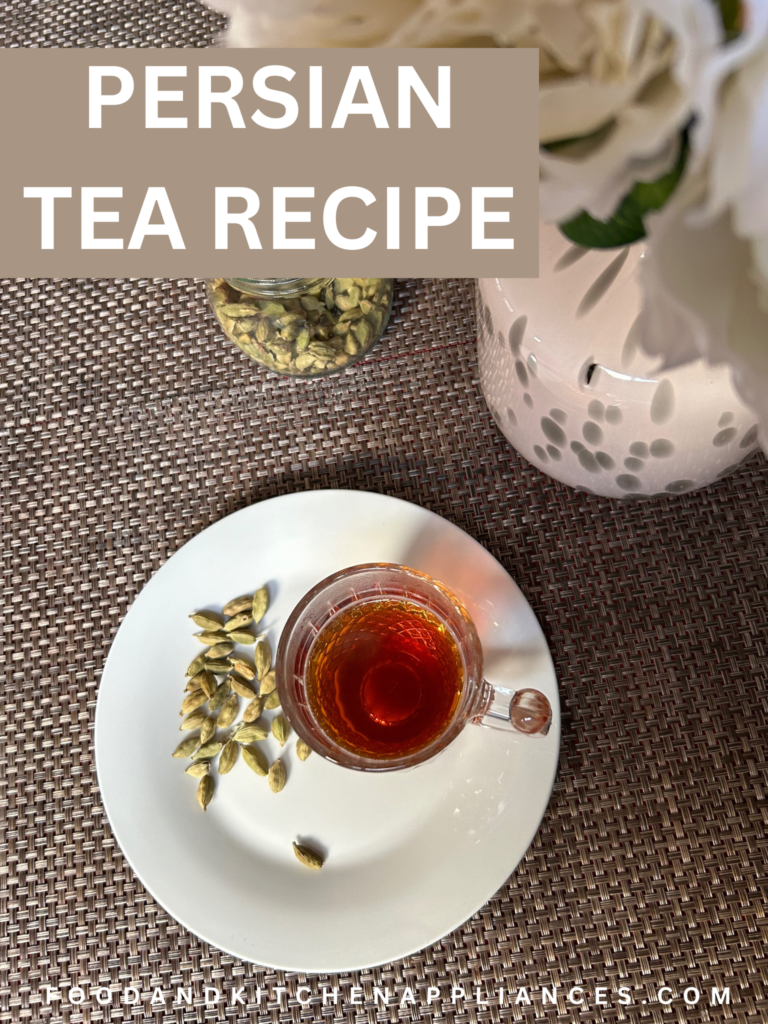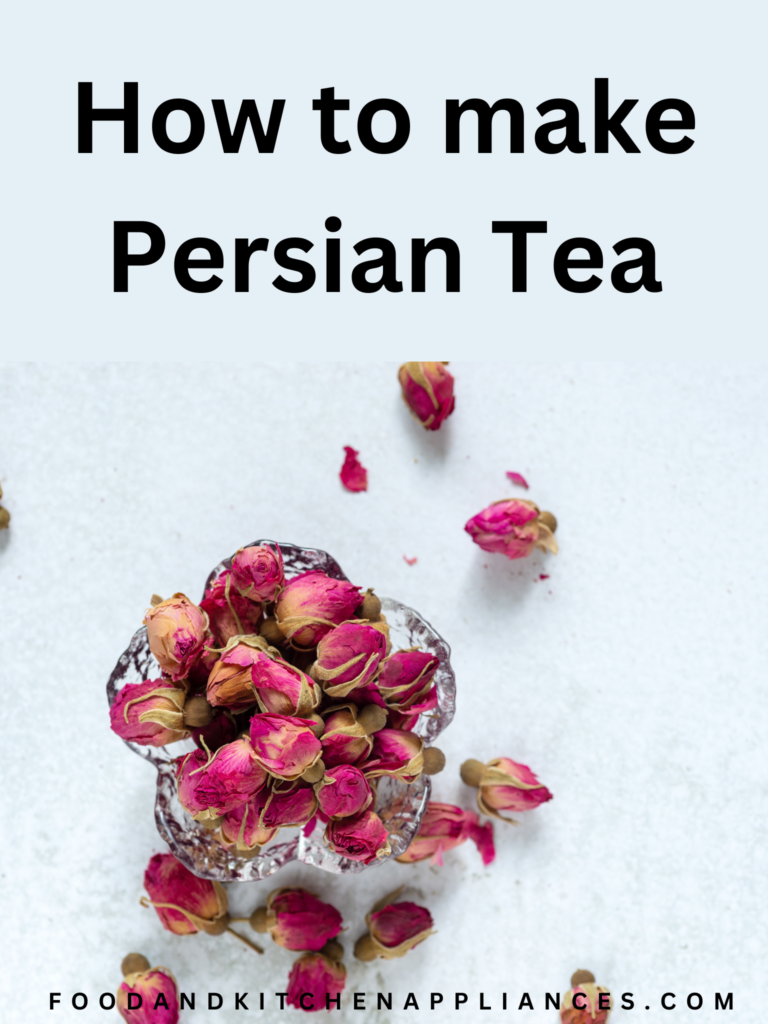If you’ve ever tasted Persian tea, you know it’s not just a beverage—it’s an experience. The rich, aromatic tea, often served in delicate glasses, is a staple in Iranian culture and a symbol of hospitality. Whether you’re a tea connoisseur or just curious about different tea traditions, learning to brew Persian tea at home is a delightful journey into the heart of Persian culture.

What is Persian Tea?
Tea, or “chai” as it’s known in Persian, is more than a drink in Iran; it’s a cornerstone of social life.
The story of Persian tea is as enchanting as the brew itself. Tea made its way to Persia in the 16th century, thanks to the vibrant trade routes connecting Persia with China during the Safavid era. Initially a luxury reserved for the elite, its allure quickly captured the hearts of all social classes.
By the 18th century, tea had woven itself into Persians’ daily lives, replacing coffee as the preferred drink. The real game-changer came in the early 20th century when tea plantations were established in Iran’s lush northern regions. This not only made tea more accessible but also cemented its place in Persian culture.
Today, sharing Persian tea is a cherished ritual to welcome guests with warmth and hospitality that transcends time.
My first encounter with Persian tea was during a family visit to a friend’s home.
Before that, I only knew regular black tea or my favorite traditional Indian Tea made with milk, cardamom, and cloves. I cannot live without having at least two cups of tea daily.
Let us again start with how I first tasted Persian tea. When I went to my friend’s house, she brought out a beautiful samovar, and the tea-making ritual began.
The fragrance that filled the room was intoxicating, and the taste was unlike any tea I’d ever had.
Since then, I’ve been hooked and learned to brew Persian tea at home, savoring its unique flavor and the memories it evokes.
Whenever I brew a pot at home, I feel connected to this beautiful tradition, savoring every sip and rich history.
How to Brew Persian Tea at Home?
The Tradition and Culture of Persian Tea
Persian tea has the cultural significance in Iran. It is not merely a drink; it’s a symbol of warmth and friendship.
It’s served throughout the day—at breakfast, after meals, and during social gatherings. Offering tea to guests is a sign of respect and hospitality.
This cultural reverence for tea has been passed down through generations, making it an integral part of Persian identity.
The Samovar: Heart of the Tea
The traditional way to brew Persian tea involves using a samovar, a metal container for heating water. On top of the samovar sits a small teapot, where the tea is brewed slowly.
This two-step process ensures that the tea is always hot and ready to be served. The samovar is not just a kitchen appliance; it’s a symbol of the home and hearth.
While modern electric samovars are available, the old-fashioned ones heated with charcoal or wood add a nostalgic charm to the tea-making ritual.
Ingredients and Tools You’ll Need
You’ll need key ingredients and tools to make authentic tea at home. Here’s a list of what you’ll need:
- Loose-leaf black tea: Persian tea is typically made with strong black tea. Look for high-quality loose leaves for the best flavor.
- Cardamom pods: Optional, but adding a couple can enhance the aroma and taste.
- Saffron: Another optional ingredient, saffron adds a unique flavor and a golden hue to the tea.
- Rosebuds( Optional)
- Water: Fresh, cold water is best.
- Sugar cubes: Persian tea is traditionally served with sugar cubes, allowing each person to sweeten according to their taste.
- Teapot: A small teapot to brew the tea concentrate.
- Samovar or kettle: To heat the water.
- Glass tea cups: The tea is often served in small, delicate glass cups, which allow you to appreciate the color of the tea.
Flavorings are optional, and you can flavor the tea however you want. I always use cardamom as I have Indian tea at home.
I don’t use Saffron and rosebuds as much in my kitchen, so I don’t add them to my Persian Tea.
But whenever I go to my Iranian friend, she always uses Saffron and rose buds to make Persian tea.
Step-by-Step Guide to Brewing Persian Tea
Now that your ingredients and tools are ready let’s begin brewing Persian tea. Follow these steps to achieve that perfect cup of tea:
Step 1: Preparing the Teapot
Add a couple of tablespoons of loose-leaf black tea to your small teapot. If using cardamom pods, lightly crush two or three and add them to the pot. For an extra luxurious touch, add a few strands of saffron.
Step 2: Boiling the Water
Fill your samovar or kettle with fresh, cold water and bring it to a boil. Once the water is boiling, pour a small amount into the teapot, just enough to cover the tea leaves.
This step is called “washing” the tea and helps to awaken the flavors. Swirl the water around for a few seconds, then pour it out.
Step 3: Brewing the Tea
Pour boiling water into the teapot until it’s about three-quarters full. Place the teapot on the samovar or stay on the stove over deficient heat.
Let the tea steep slowly for at least 10-15 minutes. This slow brewing process is crucial as it allows the flavors to develop fully without becoming bitter.
Step 4: Serving the Tea
Persian tea is traditionally served strong and then diluted with hot water to taste. Fill each glass cup about a third with the tea concentrate, then top it off with hot water from the samovar or kettle.
Serve the tea with sugar cubes on the side. The proper way to enjoy this tea is to place a sugar cube between your teeth and sip it through it, letting the sugar dissolve as you drink.

Tips for Perfecting Your Persian Tea
Brewing Persian tea is both an art and a science. Here are some tips I’ve picked up over the years to help you perfect your brew:
- Quality Matters: Always use high-quality loose-leaf tea. The difference in flavor is noticeable.
- Temperature Control: Keep the heat low while brewing. High heat can cause the tea to become bitter.
- Patience: Don’t rush the brewing process. Good tea takes time.
- Experiment: Feel free to adjust the amount of tea, cardamom, and saffron to suit your taste.
Personal Anecdotes and Memories
Conclusion
Brewing the tea at home is a rewarding experience that brings a touch of Persian hospitality into your kitchen. The process may seem intricate initially, but with some practice, you’ll enjoy a perfect cup of Persian tea, rich in flavor and steeped in tradition. Whether you’re enjoying it alone as a moment of relaxation or sharing it with friends and family, this tea will become a cherished part of your daily routine.
Have you tried brewing Persian tea at home? What was your experience like? I’d love to hear your stories and tips. Please leave a comment below and share your thoughts!
Recipe for Persian Tea:
Ingredients:
- 2 tablespoons loose-leaf black tea
- 2-3 cardamom pods (optional)
- A few strands of saffron (optional)
- Fresh, cold water
- Sugar cubes (for serving)
Instructions:
- Add loose-leaf black tea, cardamom pods, and saffron (if using) to a small teapot.
- Bring fresh, cold water to a boil in a samovar or kettle.
- Pour a small amount of boiling water into the teapot to cover the tea leaves, swirl, and discard.
- Fill the teapot with boiling water until three-quarters full. Place the teapot on the samovar or over low heat.
- Let the tea steep for 10-15 minutes.
- Fill each glass cup one-third full with tea concentrate, then top off with hot water.
- Serve with sugar cubes on the side. Enjoy
Brewing Persian tea is a beautiful way to connect with a rich cultural tradition and bring a touch of Persian elegance into your home. Give it a try, and let the warmth and aroma of this tea brighten your day.
Persian Tea Recipe to make at home
Equipment
- 1 Tea Kettle or Samovar
Ingredients
- 2 tbs Loose leaf Black Tea
- 2 Cups Fresh Water
Notes
- Add loose-leaf black tea, cardamom pods, and saffron (if using) to a small teapot.
- Bring fresh, cold water to a boil in a samovar or kettle.
- Pour a small amount of boiling water into the teapot to cover the tea leaves, swirl, and discard using a tea strainer.
- Again, fill the teapot with boiling water until it is three-quarters full. Place the teapot on the samovar or over low heat.
- Let the tea steep for 10-15 minutes.
- Fill each glass cup one-third full with tea concentrate, then top off with hot water.
- Serve with sugar cubes on the side. Enjoy

Starbucks Pumpkin spice sauce for coffee
How to use coffee pods without the machine?
Does cinnamon dissolve in coffee? How to add cinnamon to coffee?
How to prepare ground coffee at home?
Is French Press Coffee Stronger Than Drip? A Fact-Based Comparison